
Is it possible for an ERV, a whole-house dehumidifier, and a forced-air heating and cooling system to share ductwork? The answer is yes — but these systems need to be designed with care.
This article describes what I believe to be the best ways that these three appliances can share ductwork. Since there are many different products in these three appliance categories, and since each product has specific operational requirements, HVAC contractors should always follow manufacturer’s installation instructions. (In this article, references to a “dehumidifier” always refer to a whole-house dehumidifier.)
The gold standard: each appliance has separate ducts
We cannot discuss integrated HVAC systems without first speaking about unintegrated systems. By “unintegrated,” I mean that the ERV, dehumidifier, and air handler all operate independently of each other, and that each system has dedicated ductwork that isn’t shared with another appliance (see illustration below).
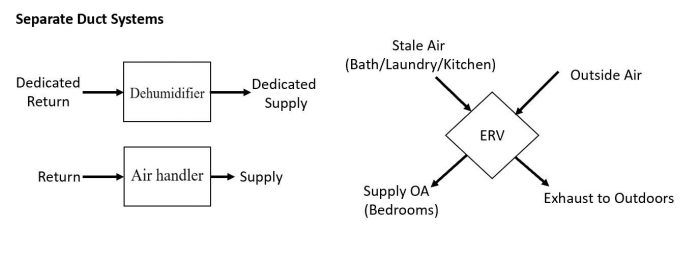
Using separate dedicated ductwork means that simultaneous operation of the blowers from two different appliances won’t cause pressure problems, and ensures that there won’t be any need for larger-than-normal ductwork. This approach may be the gold standard in terms of system performance, but often is also the most expensive.
The air handler and the dehumidifier can share ducts
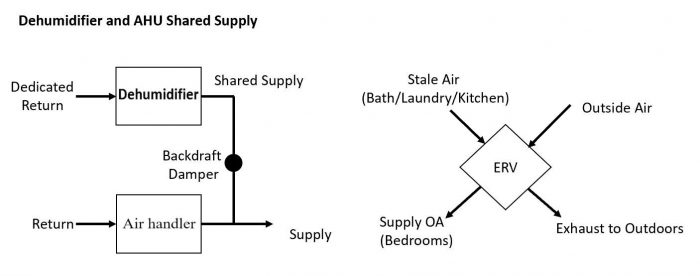
It’s possible to design a system in which the air handler and the dehumidifier share ductwork (see the illustration above). This is the most common way to integrate a dehumidifier with a forced-air heating system, with or without an ERV. With this approach, the dehumidifier and the air handler share the same supply ductwork, while the ERV uses a completely separate duct system.
With this approach, the supply ductwork must be sized to account for the extra flow of the dehumidifier. Note that if the air handler’s supply ductwork is not properly sized, it’s possible that when both the air handler and the dehumidifier operate together, one or the other may exceed the maximum operational static pressure, decreasing performance. The lower the operational static pressure when both are running, the better the performance from both pieces of equipment.
I don’t recommend supplying the air from the dehumidifier to the return side of the air handler, because during times of simultaneous operation the cumulative latent capacity is severely affected and the performance is unpredictable. (For more on this topic, see the FSEC report titled “Investigation of Energy Impacts of Ducted Dehumidifier Duct Configurations and Location.”)
The ERV and the dehumidifier can share ducts
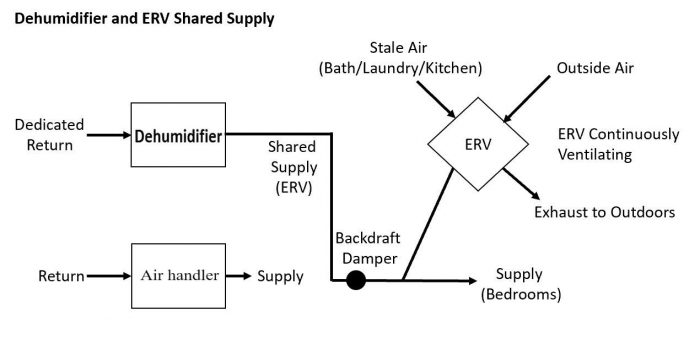
In some situations — for example, in a house with ductless minisplits, or in a house with forced-air heating and cooling with a high static duct system, or in a house with a radiant cooling system — you might want your ERV and your dehumidifier to share supply ductwork (see illustration above). These ducts are not shared by the forced-air heating and cooling system. The supply air from the dehumidifier and ERV should go to the bedrooms, while the dedicated return for the dehumidifier should pull from a large central portion of the home. The ERV should pull stale exhaust air from potentially contaminated areas. This setup requires a backdraft damper on the dehumidifier supply duct prior to connection with the ERV, in order to prevent supply air from the ERV from being supplied out the return of the dehumidifier.
The static pressure of the shared supply duct will change based on whether the dehumidifier is on or off. Depending on the ERV, this change in static pressure may change the flow rate of the outside air provided to the house by the ERV.
During commissioning, there are two ways to balance the ERV:
- Balance the ERV with the dehumidifier on. If you do this, the ERV will go slightly unbalanced and will positively pressurize the house when the dehumidifier is not on. (This is my preferred method).
- Balance the ERV with the dehumidifier off. If you do this, the ERV will go slightly unbalanced and will depressurize the house when the dehumidifier is running.
Correctly sizing the shared supply ductwork and terminations will greatly reduce the amount that the ERV goes unbalanced, one way or another.
A tandem arrangement: ERV plus dehumidifier
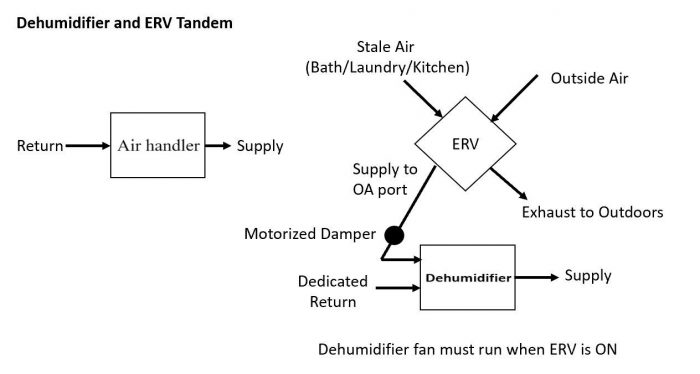
There are positives and negatives to all of the above approaches. As stated above, when a dehumidifier and ERV share ductwork, there is the potential that the ERV will become unbalanced at certain times. If this concerns you, and you are willing to turn the dehumidifier blower on whenever the ERV is on, the setup shown above may be better for you. In this case, we are avoiding the unbalanced situation; the trade-off is that the ventilation system will have a higher operating expense. The approach shown above requires the supply duct leaving the ERV to be connected to the outside air collar on the dehumidifier. It is important that the dehumidifier still maintain a return from the house, since the flow from the dehumidifier will not match the flow of the ERV supply. (There are other reasons as well – but that is a topic for another article).
A motorized damper is required in the duct from the ERV to the dehumidifier to prevent the dehumidifier from drawing in outside air when the ERV is off. This is important during outdoor pollution events (for example, during wildfires or skunk sprays) or unoccupied times (for example, during vacations or work hours). When the ERV is being commissioned, the dehumidifier should be on in order to properly balance the ventilation system.
The fully integrated “injection” approach

The last option that we will discuss is a fully integrated application (see illustration above). Both the dehumidifier and ERV are installed as injection devices in which the return and supply of these appliances are connected to the same piece of ductwork. This “injection” design creates a near zero operational static pressure for the injection devices and has no impact in terms of increased air flow (and thus static pressure) on the air handler. So there is no need to upsize the ductwork. This provides predictable performance of all the different components of the system. However, bath fans would be required with such an installation as the ERV can no longer provide removal of pollutants.
For this approach to be effective, the air handler blower must be on whenever the ERV or the dehumidifier is operating. The ERV should be installed on the return side of the air handler so that the ERV doesn’t add or remove BTUs from the supply side of the forced-air heating and cooling system. The dehumidifier ducts should be located on the supply side of the air handler so as to not reduce overall latent capacity of the system.
This approach increases latent performance (moisture removal) when the air conditioner and dehumidifier run simultaneously, as the air entering the dehumidifier is closer to the dew point. (Check with the dehumidifier manufacturer to ensure this is an acceptable application as it often is not within manufacturer’s specifications.) Yes, the sensible BTUs of the air conditioner are impacted (mechanically changing sensible BTU removal to latent BTU removal), but during peak conditions the air conditioner should be able to maintain acceptable indoor humidity levels. Therefore, during non-peak hours we have extra capacity that can be exchanged for better latent control. It should be noted that the dehumidifier will have little to no latent capacity if it operates simultaneously when the heat source for the home is on and being distributed through the supply side of the air handler.
I hope this article sparked some talking points. Integration of different systems by different manufacturers can become tricky, as each manufacturer has only their own system in mind. We all have the same goal, however: a healthy indoor environment supported by the predictable and efficient performance of the home’s HVAC equipment.
David Treleven is an industry manager at Therma-Stor where he concentrates on innovation and technical applications.
Weekly Newsletter
Get building science and energy efficiency advice, plus special offers, in your inbox.







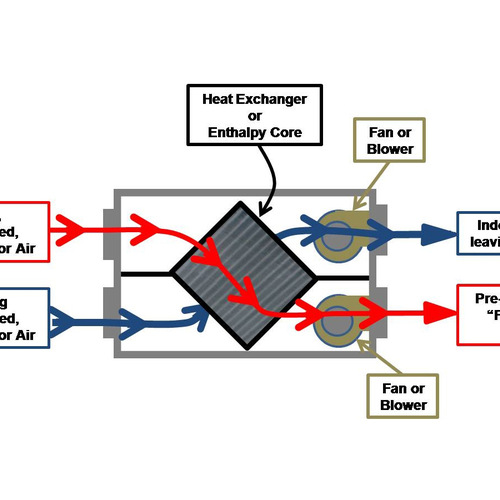
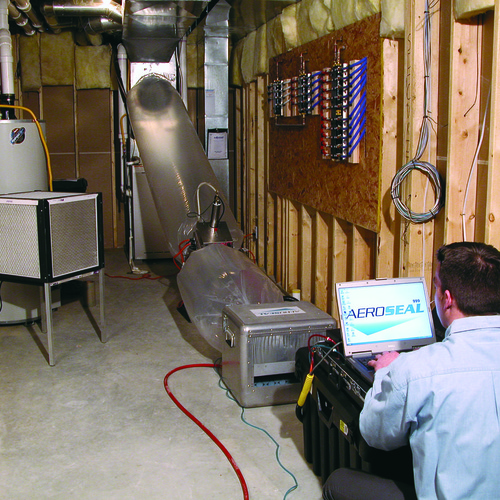






37 Comments
Intuitively, it seems like the tandem arrangement would be more effective at humidity control than independent ductwork. The incoming air has higher humidity than return air (less so with an ERV than an HRV, but true either way). It is easier to remove humidity from very humid air than from slightly humid air. So, a dehumidifier acting on very humid air should remove more moisture than a dehumidifier acting on the same flow rate of slightly humid air. I have not done any calculations to check my intuition. Have others on this forum done the math to know if my intuition is accurate? If so, is the magnitude of the effect enough to be worth worrying about?
Reid you are correct in that a dehumidifier is more efficient lb/kWh and removes more moisture when the air has more moisture. Both the tandem arrangement and shared supply by the ERV/dehu with a correctly sized/set-up AC and dehumidifier will be able to maintain interior conditions at 75F/50% without an issue. I would guess that the tandem set-up, because of the fan energy from the dehu whenever the ERV is operating, would lead to higher yearly operational cost because the dehumidifier operation will be non-existent during certain times of the year. It is also worth mentioning that the tandem set-up has the potential to re-evaporate moisture off of a loaded coil when the dehu's compressor is not running.
In the system where the air handler and dehumidifier share ducts:
a) Why not share return ductwork as well as supply?
b) Would it make sense to interlock the devices so they never operate together? My understanding is that dedicated dehumidifiers are mostly needed during shoulder seasons when neither heating nor cooling operate very much.
Sharing the supply and return duct will increase the operational static pressure on both units when they operate together. The shared supply between the AHU and dehu will also increase the operational static but by a lesser degree – one which we are more comfortable with the performance. One way around this, as you point out, is to lock-out the AHU or the dehu when the other is operating. This may be a good solution in certain applications such as retrofit where you have high statics and/or have to hook the dehu up in the return to supply of the AHU. If possible, I prefer to allow all the pieces of equipment to operate independently as needed. In higher performance homes the heat generated by long dehu cycles needs to be offset by the AC which if it is locked out may cause temperature swings and the resulting comfort issues.
1. I'm of the belief that if a house has a properly designed, install and commissioned HVAC system, there would be no need for a dehumidifier, unless the house is in a high humidity area, like golf coast states, etc.
2. Most houses in North America require between 40-100 cfm of continuous makeup air; so why not use one or two spot ERV/HRV (ceiling mounted) and not mess with any complicated duct system and/or any of the possible headaches described above?
We've used Panasonic, Fantech or Broan to great success. Is my thinking wrong somehow?
If the house has a properly designed, installed, and commissioned AC system you maximize your moisture removal and thereby minimize the potential for needing a dehumidifier or reducing the dehumidifier run time. Properly designed HVAC according to ACCA changes when low-load homes are built as seen in the new LLH Manual. The one thing to remember is that AC only removes moisture when it runs – locations such as Raleigh where I live sit at 75F (often near saturated) a good portion of the year and therefore we have limited AC run times. Different climates, types of construction, mechanical equipment, ventilation rates and occupant behavior my result in the AC not being able to maintain the interior requirements of the occupants. Your solution of using spot ERV/HRVs reduces the complexity of sharing duct systems. I do not think your thinking is wrong as long as the HVAC design has the capacity to deal with the ventilation load from the ERV/HRV to maintain interior conditions and you have good air mixing in the house to distribute the ventilation air.
Has anyone read Mechanical and Electrical Equipment for Buildings by Stein & Reynolds? It's one of those touch-stone books for architects and engineers. In my scan of this article and comments, it seems the topics being discussed are addressed in-depth in that book. If you're an architect, engineer, or good contractor, it's probably worth a read. Even though ERV's and HRV's get marketing hype as somewhat new-fangled gadgets that are going to help us save the world, they've been around for quite a while. Cheers.
In your last 'injection' example, there would seem to be two very considerable problems;
1) Fresh air will be distributed throughout the house during the night so only a very small portion will make its way in to bedrooms where it is needed the most. This could or likely will result in much too high CO2 levels?
2) This requires the AHU blower to run anytime the HRV or Dehu are running. Even with a good ECM motor this would seem to require a lot of unnecessary energy (and $'s). If you then want to try to reduce the CO2 in bedrooms you'll need to run the AHU blower even more to circulate air.
Am I missing something that this configuration is presented as somewhat recommended?
Regarding your first point, I question the idea that fresh air should be directed exclusively to bedrooms. During the daytime, the people in my house tend to congregate in the family room and kitchen, which I suspect is typical in other people's houses also. Is fresh air not important during the daytime? Short of a zoned ventilation duct system, I don't know of a better solution that providing fresh air to both the bedrooms and the family room even if that requires a higher ventilation rate than targeting the fresh air to only occupied rooms.
An important difference between the bedrooms and the living room is that bedroom doors are typically closed at night. However, it's pretty common practice to have fresh air delivered throughout the house when using a balanced, distributed system (the gold standard for fresh air delivery). I've heard at least one expert suggest that you CAN get away with providing fresh air only to the bedrooms, but never heard it said it was necessary or that having fresh air delivered to the rest of the house at night is bad. I've never heard of a ventilation system that shuts off zones based on time of day. That seems needlessly complicated, and would present its own problems (what happens when you alter your schedule?).
This is the complete opposite of everything I've read which is that the absolute best option for an HRV/ERV is to pull stale air from bathrooms, kitchens and laundries and deliver fresh air to bedrooms.
W.,
I agree with you. Ideally, an HRV or ERV has dedicated ventilation ductwork. Attempts to share ducts with other appliances always result in compromises and reduced effectiveness.
I assume that the author of this blog, David Treleven, agrees, since he wrote, "Using separate dedicated ductwork means that simultaneous operation of the blowers from two different appliances won’t cause pressure problems, and ensures that there won’t be any need for larger-than-normal ductwork. This approach may be the gold standard in terms of system performance, but often is also the most expensive."
To build on what Trevor said based on my limited understanding...
During the day you are in a fairly large space so the number of people producing CO2 per cubic foot is quite low and on top of this you have people going in and out opening exterior doors. As well, the fresh air being delivered directly to bedrooms during the day does get distributed throughout the entire house. (HRV > Bedroom > return duct to AHU > distributed throughout house).
At night you are typically in a smaller closed space so the CO2 producing humans per cubic foot is much higher. The fresh air coming in to the duct is distributed throughout the house so perhaps only 10-20% is reaching the bedrooms which is insufficient.
Leaving the door open a little is also fine. If not, then you should have 15 CFM per person to or from the room. Similar CFM are needed for odor control.
Say 20+ CFM/person in a closed door den or office (more CO2 being produced, more important to think clearly). The single room might need > 100% of the home's HRV/ERV output (eg, 60+ CFM for 3 people). This is not how residential systems are being designed.
Code doesn't require delivery to specific rooms - but this is "the worst you can legally build" and will have negative health effects. But start designing ventilation for 15+ CFM per possible or actual person in each room with a door (skip short term occupancy rooms) and you get some alarming total house CFMs. Maybe occupancy sensors/zoning makes sense in such cases. Or fan(s) to move air from the closed door room to the rest of the house. This provides the beneficial CFMs without increasing outdoor air exchange.
Edit: Want to maintain 600 ppm while sleeping? I calculate 25 CFM/person.
About the sleep benefits:
https://www.ncbi.nlm.nih.gov/pubmed/26452168
Realistically, if we are to provide a healthy environment, we likely need to start maintaining about 600ppm CO2 for occupied rooms (and at some point we should establish healthy maximums for other VOC's and PM2.5?). At least that is the direction that medical science is pointing. It's possible that 800 or 1000ppm are not detrimental but that doesn't appear likely. Any requirement would likely also have to account for high outdoor levels so 600 or 100 over ambient if ambient is greater than 500?
Two likely options;
1) Deliver fresh air directly to critical rooms - bedrooms & offices - at a rate that we know is likely to be sufficient.
2) Inject the fresh air in to the common duct system. We know this alone will often not achieve healthy air in closed bedrooms, offices and ?? so either keep the AHU on recirc, program it to recirc on some schedule, or have monitors in rooms that trigger recirc.
Even with good ECM motors I'm not sure the latter won't get quite expensive with energy use & $'s for that energy use?
* Offices have one advantage in that the AHU is likely running more during the day and so providing more recirc air to the office?
> there are two ways to balance the ERV
Or the third way - get a self-balancing ERV with enough fan power to overcome pressure changes caused by other systems. Review the numbers and you will find that most already have sufficient power.
> This “injection” design creates a near zero operational static pressure for the injection devices
It does for the dehumidifier, but not for the ERV (where pressures are referenced to outdoor pressure). When the air handler increases flow, ERV return (stale) will decrease and supply will increase (but self-balancing fixes this).
You should explore another option - fully integrated parallel. Air handler, ERV and dehumidifier are all in parallel and each has a damper and sufficient automatic/variable fan power to maintain correct flow no matter what other parallel devices are doing. The ERV already exists, I haven't looked for variable fan central dehumidifiers.
If someone is looking for a product idea (but could already exist): produce a variable speed duct fan that neutralizes pressure. No matter what pressure the A side is at, the B side will be adjusted to equal ambient pressure. With such a product, "dumb" devices can be operated in parallel without effecting the flow rate through them (they always see ambient pressure at both terminals).
Most US homes require a dehumidifier to maintain ASHRAE recommended comfort levels.
Jon – I appreciate your comments and correction to my post. As you pointed out, the ERV does not see near zero operational pressure in the ERV in the fully integrated design as its reference is to outside (if the ERV is balanced it will exert zero additional static on the AHU). Multi-speed AHUs with self-balancing ERVs is a great solution if the ERV is integrated with the AHU ductwork. Self-balancing ERVs also are also one of the few ways to maintain predictable performance post commissioning as the intake filters (or outside intake) often clog up quickly. It is my experience that these filters/intakes are not cleaned as often as they should be by occupants and thus the balanced system is often unbalanced.
As for the suggestion for fully integrated parallel. As far as I know, variable speed fans in ducted dehumidifiers do not exist. You could run the ERV & AHU in parallel and the dehumidifier as injection on the supply. By putting the dehumidifier as injection it would keep the duct sizes smaller (ducts sized for the max flow of the ERV & AHU – not the dehumidifier as well).
It's great when guest blog authors respond to comments.
I agree that running the dehumidifier as injection with a tie-in to the AHU fan is reasonable. Hopefully with a way to signal the AHU fan to run at low speed. See CO2 comments in #8.2,15,16 about why you want to run the AHU anyway.
Duct up-sizing with parallel is a minor issue. For example, central AC might need 1200 CFM. Add 100 CFM for parallel ERV and 200 CFM for parallel dehumidifier. You might end up with the same ducts. Or just slightly larger. Much cheaper than separate ventilation ducts.
Separate ventilation ducts is a significant expense and will be inadequate in many cases. Finding a good alternative is important.
Why is it that the “injection” design creates a near zero operational static pressure for the injection devices?
I saw this too in the recent Florida Solar Energy Center report FSEC-CR-2038-18. If it runs at near zero operational static pressure, wouldn't just be recirculating the air?
> The gold standard: each appliance has separate ducts
Code min CFM, separate ERV ducts, no AHU use and closed doors is typically going to lead to unhealthy CO2 levels and odor problems - the numbers don't add up no matter where you run the ducts. It can work with more CFM (eg 2x code min).
I suggest that the gold standard might be an ECM AHU running continuously at slow speed. With a self-balancing ERV and no separate ERV ducts. Fan power is exponential, so the AHU power needed for low flows is a non-issue (eg 10W).
Variable speed furnace fans and self balancing ERVs have changed things. Perhaps it's time to update recommendations.
Do you mean that the ERV uses the AHU ducts?
> Do you mean that the ERV uses the AHU ducts?
The first sentence refers to separate ducts, the second refers to shared ERV/AHU ducts. But in rereading it, I should have said just "standard", ie, perhaps a good trade-off between function and cost. The best you can do at any price is about what David said - independent control of humidity, temperature and ventilation. Plus independent zoning for each room with automatic controls.
I think it's a good exercise - start with ideal, then look at the cost savings vs performance loss of compromises.
Which ERV would you recommend for this set up?
I plan to do what Jon is recommending. The new air handlers are very efficient when they have a variable frequency drive built into the controls. That combined with a self balancing ERV allow it to use the air handler to mix and distribute the air. My difference is that the air handler will have a chiller water coil coming off an air to water heat pump to dehumidify the air. That allows any moisture from the occupants or the outside air is controlled. It also allows you to control the moisture in the building and divert any condensate to a drain.
I think that's a cost effective approach. But note that humidity, heat, cooling, VOC, CO2, PM2.5, etc loads aren't proportional across rooms or time.
Also note that dehumidifying coils have very specific CFM requirements.
I realize this thread is old, but hoping for some advice as I'm renovating my basement to deal with my family working/learning from home during COVID and beyond. The house is a 1955 brick/block Ranch in Northern Virginia, with a 3T Trane ac in the attic and a separate baseboard heating system for the 1st floor only. I have no heating or ac in my basement--no ducting and no good place to run one from the attic. SF is approx 3000 total with a West facing open rear basement. The Trane and baseboards keep the 1st floor comfy. The basement is very muggy particularly in a couple of closed rooms (front/East facing side) which I need to finish and turn into office/learning space. I hate stand-alone dehumidifiers...loud, ugly and there is no good way to drain one sitting on the floor without carrying buckets of water. I'm considering a two head mini-split heat-pump to wash the West facing/rear/exterior basement walls and should help the adjacent rooms, however, I'm concerned that those won't dehumidify those East facing rooms quite enough once I tighten the envelope. Ideally I could find/mount a dehumidifier between the joists and from there drain condensate out of the side of the house. I have considered the Panasonic WhisperComfort ERV in conjunction with the mini but not sure that will solve the humidity problem. I've also considered using a WhisperValue fan to pull dry air through wall vents and then pumping the humid air to the mini-split. As mentioned, I've looked for a small in-ceiling dehumidifier that I can drain through the joists with no luck. Is there such a thing? Anything else I should consider?
You can buy in-wall dehumidifiers and ducted ones. Add a condensate pump if needed to get to a drain.
A mini-split will not provide enough dehumidification under all circumstances. Ever more so in a basement. Neither will an ERV.
JonR, Thanks for the reply. You are confirming what I've read. I've been looking at the possible dehumidifiers, but there always seems to be some major drawback. Noise is one and size is another; not to mention cost. As much as I hate to do it, the Aprilaire 1830 (~$1,200), mounted on a shelf or suspended in the offending storage space seems to be the best possible solution.
If you are going to go for an expensive top quality one my impression is that Thermastor has the best ones. But I haven't done side-by-side comparisons myself or anything.
For the injection model, is there a static pressure benefit from having the dehumidifier injected into the supply side vs the return side between the erv and AHU? I currently have my dehumidifier injected on the return side but on hot summer days in the Midwest I’m lucky to keep the house at 50% RH even though my set point is 45% and it runs 24/7. Am I likely to notice a performance increase by injecting It into the supply side instead?
> I currently have my dehumidifier injected on the return side
Injecting heated and dehumidified air before the AC evaporator will reduce the dehumidification performance of the AC. The AC sends waste heat outside - so if it's hot outside, you want it doing as much of the dehumidification as possible.
Do we know that? And for what conditions?
Even if it did reduce the performance of the AC evaporator I'd think that it'd be only under certain conditions and not others? And then placing the dehumidifier AFTER would then likewise reduce the performance of the dehumidifier? So for best dehumidification you'd need them in parallel but then you'd be introducing somewhat uncooled air in to the supply side and so reduce the cooling performance of system?
I get that, but my thermostat allows for locking out the dehumidifier during a cooling cycle. According to this info at https://www.pvhvac.com/blog/why-your-whole-house-dehumidifier-cant-keep-up it would appear as if an injected dehumidifier on the return side only would introduce extra static pressure on the dehumidifier resulting in reduced performance. This article says the injected method on the supply end “creates a near zero operational static pressure for the injection devices”, so wondering if there was more to the supply side recommendation than avoiding sending heated/dehumidified air through the AC evaporator?
If you are never going to be running the dehumidifier at the same time as the AC fan, then IMO, injecting into the supply or return is fine, with the supply probably being better distributed. Either injection point with the AC fan on at the same time will effect the pressure seen by the dehumidifier.
In my furnace, I have a Lennox clean climate 16 (merv-16) 5” filter. I am injecting my dehumidifier (an ultra-aire 98H) on the return side before the furnace. I am needing to replace the dehumidifier filter and have 2 options, merv-11 or merv-13. Is there a recommendation of which merv rating would work best in terms of static pressure/dehumidification performance, or would the difference be insignificant? I also have an erv injected into the return before the dehumidifier that has a merv-13 filter in it. Choices of that are merv-8 or merv-13.
Joe consumer here, sitting in 90 degree room waiting for AC tech and quote on new system for my 1961 house with a 20yo Wards unit. Live in Virginia where it is too humid for my Calif. body half the year. We had the independent De-Humidifier installed a few years ago, added return ducts to basement and kitchen. It blew warm air and smelled musty, she made me turn it off after weeks and I wasted $4k. Not sure if the warm supply is a cheap unit but I would never do that again. Are there integrated units that control humidity and cold air independently for those shoulder seasons? Recommendations?
Is it possible to combine the tandem approach and the injection approach? So the injection setup, but there is an additional connection from the ERV supply to the (ventilating) dehumidifier. This would improve the efficiency of the dehumidifier. The connection between the ERV and dehumidifier would need a damper to turn off when the dehumidifier is off (as per the tandem setup). But could it work well to instead just always run the ERV when the dehumidifier is running?
Log in or create an account to post a comment.
Sign up Log in